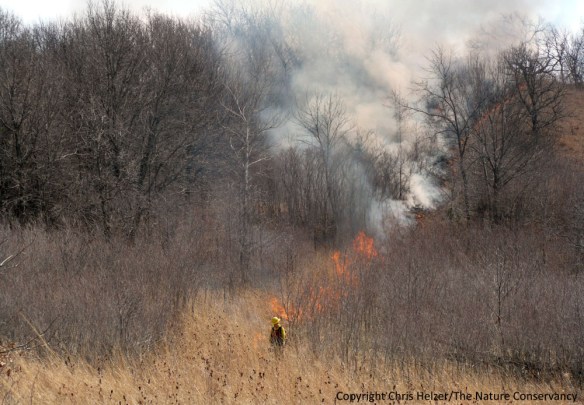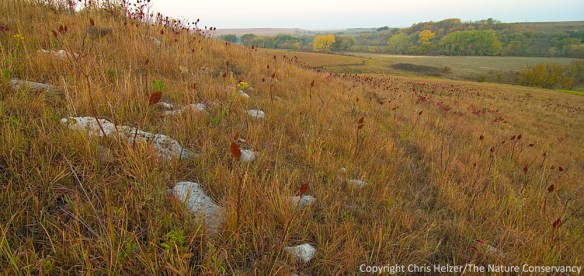Last week, several of us from the Platte River Prairies traveled south to visit the Konza Prairie Biological Station near Manhattan Kansas. Konza Prairie includes about 8,600 acres of prairie, jointly owned by Kansas State University and The Nature Conservancy. The prairie is managed and used as a biological station by Kansas State University’s Division of Biology, but hosts research projects from scientists around the world. The biological station has a three-fold mission: long-term ecological research, education, and prairie conservation.
Research results from Konza Prairie have been very influential for grassland managers across the world, but particularly in western tallgrass and mixed grass prairies of North America. Over the next couple of weeks, I’m going to report on several topics we discussed with researchers at Konza during our trip. Today, I’ll just give you an overview of the site and our visit.

Annually-burned prairie near the headquarters of Konza Prairie near Manhattan, Kansas. It has been very dry there since early summer, so much of the vegetation – including compass plant – is shorter than usual.
We had two main reasons for our trip to Konza. First, our two Hubbard Fellows, Jasmine and Dillon, are designing research projects on small mammals and grasshoppers, respectively, and wanted to learn from Kansas State researchers on those topics. Second, researchers from Konza Prairie have produced some of the most important grassland science there is, and we wanted to learn as much as we could by touring the site with some of those researchers.

Our Nebraska crew in Kansas. From left: Jasmine Cutter, Chris Helzer, Dillon Blankenship, and Nelson Winkel.
Thursday evening, we arrived just in time to take a short hike near the headquarters as the sun was going down. Then we went to bed early so we could get up before the sun Friday morning and accompany researcher Drew Ricketts as he checked his small mammal trap line. Drew is comparing the small mammal communities between patch-burn grazed prairie (with cattle), annually burned/grazed prairie, and ungrazed prairie burned every four years. Jasmine wanted to see his trapping and handling techniques and get some tips on identifying some of the species.

The crew watches Drew and his assistant, Kyle (right) examine and record data from captured small mammals.
After we spent a couple hours with Drew, we met up with Kansas State professors Tony Joern, John Blair, and Jesse Nippert and started a four hour tour of the site that was so full of information and ideas my head is still spinning. We looked at the portion of the site grazed by a herd of 400 bison and talked about the impacts of bison vs. cattle grazing, the role of bison in keeping cedar trees out of prairie (they’re good at it), and several other related topics. Next, we drove through the ungrazed watersheds of Konza that have been burned on frequencies of 1, 2, 4, 10, and 20 years since as far back as 1978. The plant composition and habitat qualities of those areas have diverged in very interesting ways through time. We finished by looking at a (fairly) new restoration project and some small plots treated with various fire regimes and fertilizer treatments. Along the way, we talked about myriad other topics as well…

Patch-burn grazing was being used in a portion of Konza prairie. These cattle were grazing in the most recently burned patch, creating habitat of short grass and tall forbs (wildflowers). Ungrazed forbs in this photo includes leadplant and purple prairie clover. Research has shown higher diversity of many invertebrate and other animal groups in this kind of habitat than in more uniformly short or tall grassland habitat.

The Flint Hills prairie in Kansas is named for the shallow layers of bedrock beneath the surface. There are also many scattered rocks in the prairie that are easy to see after a fire or grazing event opens up the vegetation.

The tour group included (from left) Dillon Blankenship, Jesse Nippert (KSU), John Blair (KSU), Jasmine Cutter, Nelson Winkel, and Tony Joern (KSU).
By the time Tony, John, and Jesse headed back to campus, we were ready to head home – not because it was hot (it was) or because we were hungry (we were), but because we didn’t feel like we could cram any more new information into our heads. As I said at the beginning of this post, I’ll try to synthesize some of that information for you over the next couple of weeks, but I’ll also try to put it into small manageable doses.
Stay tuned!







